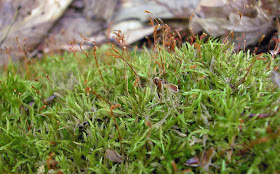DO: Go out for a walk and just start noticing the mosses. Look at the colors and textures and see if you can tell that some of them are different from others…look on rocks and trees and on the ground…you don’t have to go anywhere special, they grow everywhere.
DO: Try to pick out a moss that looks really distinctive to you.... keep walking and see if you can pick it out again. I call this the ‘There it is again’ technique and this will be critical in making your first successful identifications.
DO: Describe the moss out loud as you’re looking at it, starting with the capsule. Is it erect or curved? Does it have a teeth? Long seta or none? What shape are the leaves? Are they toothed? Does it have a costa? Any vegetative (gemmae) visible? The more you can describe it, the more you have to work with to try to identify it.
DON’T: Collect the scrawniest, scrappiest moss you can find thinking it’s going to be something rare because usually it’s just a scrawny, scrappy piece of something common that just makes it hard, or usually, impossible to identify.
DON’T: Automatically assume that the capsules you see go with the moss that you’re looking at! Mosses like to hang out together and grow all mixed up...that capsule might be coming from a moss growing underneath or mixed in the one that you are trying to identify.
DON’T: When collecting mosses to bring home to identify - don’t take the entire patch! Bryophytes take a long time to grow and you only need a tiny piece for identification. An inch square is more than ample for a specimen.


















































